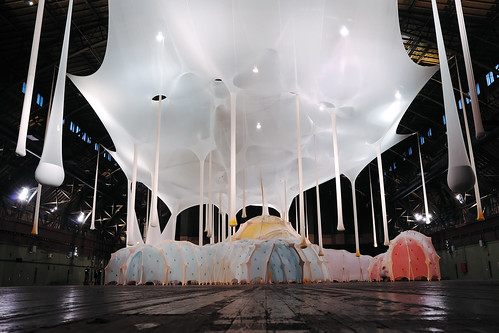Ernesto Neto
Anthropodino
Seventh Regiment Armory
Park Avenue and 66th Street, New York
May 13 - June 14, 2009

May 14, 2009.
In Brasil, to call someone or something "ginga" (pronounced ZHEEN-ga)
is to offer a high compliment. Ginga connotes an intuitive, mystical quality of movement and attitude that Brasilians like to think is uniquely theirs, permeating the way they walk, talk and dance, part of everything they do. It is a synthesis of mind and body, a state of corporeal grace informed by intelligence, creativity and rhythm. Most frequently applied to the "beautiful game" evinced by the star players of Brasilian fútbol, ginga is also evident in the Escolas de Samba, and in the other athletes, musicians, actors and artists who are the pride of Brasil.
When Ronaldo fakes out a defender with his splendid footwork and executes a somersault kick into the net, this is ginga. When Caetano Veloso sings and plays guitar on "O leãozinho", this is ginga. And now, Ernesto Neto, a true Carioca, an artist who lives, works and takes inspiration from his hometown of Rio de Janeiro, has successfully exported ginga to New York for his month long playground and sculptural installation in the huge Drill Hall of the Seventh Regiment Armory on Park Avenue.

Anthropodino, Neto's biomorphic sculpture of stretched, translucent Lycra, is a purposefully subversive intervention, a curved, sinuous expression of the body in the otherwise foursquare, "regimented" space of the Armory. It is a physical realization of the Jonah and the Whale archetype from the Bible, allowing us to walk within the belly of the leviathan, to mischievously peek out from under its ribcage. A maze of arched tunnels, given their tent-like structure by what the artist facetiously calls "dinosaur bones", lead to a central cupola, an allusion to the Crystal Palaces of the late 19th Century. These imposing architectural wonders enlarged on the basic idea of the greenhouse - glass panes, steel frames and struts - to enclose yawning spaces with cathedral ceilings (much like the Armory itself) that were used for large social functions like train stations, botanical gardens or pavilions for international expositions.

Highly engineered yet voluptuously free, Anthropodino plays with the dualities of nature vs. nurture, of the machine in the garden. This duality continues formally in the very construction of the piece, which is not only built from the ground up but also hangs from the Armory's trussed ceiling. Complementing the leviathan/dinosaur on the distressed plank floor is a vast, suspended, diaphanous membrane punctuated by long "stalactites" of the same stretchy fabric, weighted with sand and various powdered spices to terminate in sac-like nodes and pods. The overall effect is mysterious and primeval, like vestigial life forms discovered in a forgotten Amazonian rain forest.

Both floor and ceiling work are, in fact, familiar aspects of Neto's consummate oeuvre. The hanging element goes back (at least) to 2001, when O Bicho (The Animal) was shown during the 49th Venice Biennale. It continues as a centerpiece of the Margulies Collection in Miami. And a prototype of the floor construction was included in Neto's last show at Tanya Bonakdar Gallery in New York in October 2008. But never before have the two elements been synergistically combined in a tour de force installation. Or rather just once before: curator Tom Eccles indicates that a similar melding was exhibited last year in Rome. Still, the synthesis of floor and ceiling working together helps to fully exploit the scale and complexity of the Drill Hall as a container for art.
I have been able to view Anthropodino three times: first while it was still under construction, then at the press preview, and finally at the evening vernissage. During the morning press event, Neto gave an extended talk, although the word "extended" barely suffices to describe the range of free associations and voluble intellectual concerns displayed by the artist in these impromptu sessions. He is like a jazz musician, riffing on a theme. Once he gets started it is both impossible and counterproductive to try and stop the flow. But his generous curiosity is a great boon to any critical discussion of his work. My reactions to some of the issues he raised during that talk will inform the rest of this review.

1. Is Brasil a "Western" country? During his residency at the Calder Foundation in France, Neto was amused to learn that Brasil is not considered "Western" by many Europeans, due to the African and Native American (non-European) sources of its culture - although similar conflations in the United States, for example, do not interfere with our nation being perceived as "Western". But rather than viewing this as a fundamental tragedy, Neto chooses to interpret the misunderstanding as essentially liberating. He can now be happily non-Western, no longer constrained by a potentially deadening aesthetic tradition.
The title of the show, Anthropodino, is Neto's punning reference to Anthropophagia, a modernist aesthetic theory celebrating Brazil’s history of cultural cannibalism: that by ingesting and assimilating elements of other nations, Brasil is able to reinvigorate itself and assert independence over European colonial hegemony, in much the same way that the rite of cannibalism strengthened the autonomy of certain indigenous tribes. The Manifesto Antropófago (Cannibal Manifesto) was written by concrete poet Oswald de Andrade in 1928, although some of its application came years later in the art and music of 1960s Tropicália: musicians like Gilberto Gil, Jorge Ben and Veloso, and artists such as Hélio Oiticica and Lygia Clark.
2. Making art should not be such a "serious" endeavor. Neto does not wish to conform to the solemnity of careerism, which he feels is ultimately dependent on guilt. Art should revolve about play, improvisation, intuition. See "ginga" above.

3. There is a certain elegance in compactness and portability, a lesson Neto claims to have learned from the itinerant merchants of Rio, who unpack their wares and assemble impromptu stores right on the street. Similarly, the artist is capable of creating vast installations after unpacking the contents of three shipping crates. All the elements for Anthropodino, the fabric, the "bones", the thread and tools, are contained in a fairly modest package. This strategy recalls musician Robert Fripp's self description as a "small, mobile, intelligent unit". Neto's economy of means is a decidedly "green" assertion of his overall biomorphic gesture.
4. Neto advances two distinct models for making sculpture. Carving marble involves a maximum initial effort. The material is relatively obdurate, hard to fashion. But once you complete a work, it will last forever without much maintenance. It is, as it were, carved in stone. Then there are more pliable materials, like wood, bamboo, even living vegetation. These can be shaped quickly and easily, but will also rapidly devolve. Their intrinsic entropy will require frequent, fundamental maintenance, a sort of micromanaging. Neto apparently favors the latter model in his own work, and is constantly fine tuning, fitting things together, making everything work. He is a tinkerer, a bricoleur, Dionysian rather than Apollonian. His artistic synthesis accepts both creation and decay as touchstones.

5. Children and adults coexist in the "real" world. They should also do so in the art world. They maintain two intersecting dialogs under one social umbrella. At gatherings of family or friends, kids generally run around while the adults sit and talk and drink beer. Like his curator Eccles, Neto is a happy dad, and the two have conspired to make Anthropodino "kid friendly", with autonomous, adjunct, "domestic" constructions that play off the central leviathan. There is a carpeted area, several enclosed padded pavilions for tumbling and cocooning, and a swimming pool where the "water" is connoted by a sea of small blue spheres.
6. Brasil is a culture of the body. Nakedness, or an exceptional degree of bareness on beaches or at Carneval, unites with a visible tradition of outdoor performance. Culture is often experienced in mass and in public. Neto tends to incorporate interactivity in his large installations precisely to activate that sense of communal joy and the poetry of mass participation. This links him to the larger practice of Relational Aesthetics.
7. Neto posits a dialectic between the sexy and the sensual. Buying and selling stocks in periods of economic prosperity, busy commerce, chatter and social glitter - these things are sexy. But the sensual is slower, rooted in a fundamental sadness, in tragedy. The artist contrasts the two, remembering his last visit to New York in October 2008, when the market was crashing and tragedy was in the air. With his brooding animal and vegetable forms, Neto seems to favor the deeper, more pensive approach of sensuality.


Finally, a word on the spices. Neto is an amiable practitioner of gesamtkunstwerk, and his efforts at "total art" extend in Anthropodino to a palpable sense of smell. He used nearly a ton of powdered cumin, clove, coriander, black pepper, ginger, turmeric, chamomile and cayenne to weight, stain and effuse the various Lycra pods and nodules that hang from the ceiling or inside the ribbed leviathan, creating a heady scent within the large confines of the Drill Hall. Beyond a desire to enchant us with the good air, I detect a whiff of Candomblé or Macumba, the Afro-Brasilian versions of Santeria, in the choices and distributions of the spice, something owed to the non-Western part of his Brasilian heritage. As I am not versed in local tribal practices, the best I can cannibalize from my own cultural referents are the chakras of Kundalini Yoga, wherein certain colors and symbols are used to represent the energy centers and spiritual nodes of the body. When I asked Neto about the spice, he indicated there was a system in play, culminating in cayenne, the densest, most redolent spice, at the very heart of the installation, to "raise the emotional temperature".

Slideshow of "Anthropodino"
A slideshow of Anthropodino is now online.